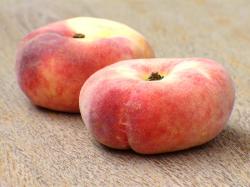What Is A Donut Peach And Why Are They Everywhere Right Now?
August 29, 2018 | 2 min to read

This summer’s been called The Summer of Sleaze, of Rage, of Missing Out, and of Scam. Might I be so bold to throw my hat into the ring and call it The Summer of the Donut Peach?
Okay, so maybe it’s a stretch, but I’ve seen more squat, pancaked peaches—which are sweeter, milder, and less fuzzy than their spherical sibs—this year than ever before. What once seemed like a rarity, sold at only the fanciest grocery stores (when Florence Fabricant wrote about “a new kind of white peach” sold at Grace’s Marketplace in 1993, she called the fruit “juicy and luscious” though “peculiar” and “positively deformed”) has become commonplace: crates piled high at the farmers’ market, clamshells for sale at Whole Foods and on Fresh Direct. I love their name, their look, and their feel, and I can't leave the market without buying at least one for each palm.
With such a funny shape (they’re like the Persian cats of peaches), you might assume there’s some funny business going on with their breeding. But flat peaches aren’t genetically-modified oddities at all: They’re the descendants of wild pan tao (also called peento) peaches from China, which were introduced to the US nearly 150 years ago. It wasn't until the ‘60s and ‘70s, however, that scientists at Rutgers New Jersey Agricultural Experiment Station hybridized the plants to produce hardier, frost-resistant trees with bigger, sweeter, peachier fruit. They called the fruit, low in acid and high in sugar, the Saturn (you can guess why).
To read the rest of the story, please go to: Bon Appétit
